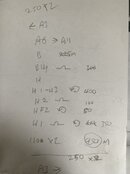My response to people who rely on notes (whether they be detailed as hell or simply navigational directions):
What if you drop your wetnotes? Now you're lost in a cave.
What if visibility is compromised? Now you're lost in a cave.
If you can't remember exactly where you are you are too far in the cave.
(No, this obviously does not apply to explorers and the like. Which you are not. Otherwise you would be exploring and not on Scubaboard. Nor does it apply to hasty non-survival-dependent notes one might take for one's personal dive log later, those are cool and demonstrate a thorough spirit.)
What if you drop your wetnotes? Now you're lost in a cave.
What if visibility is compromised? Now you're lost in a cave.
If you can't remember exactly where you are you are too far in the cave.
(No, this obviously does not apply to explorers and the like. Which you are not. Otherwise you would be exploring and not on Scubaboard. Nor does it apply to hasty non-survival-dependent notes one might take for one's personal dive log later, those are cool and demonstrate a thorough spirit.)



 .
.


